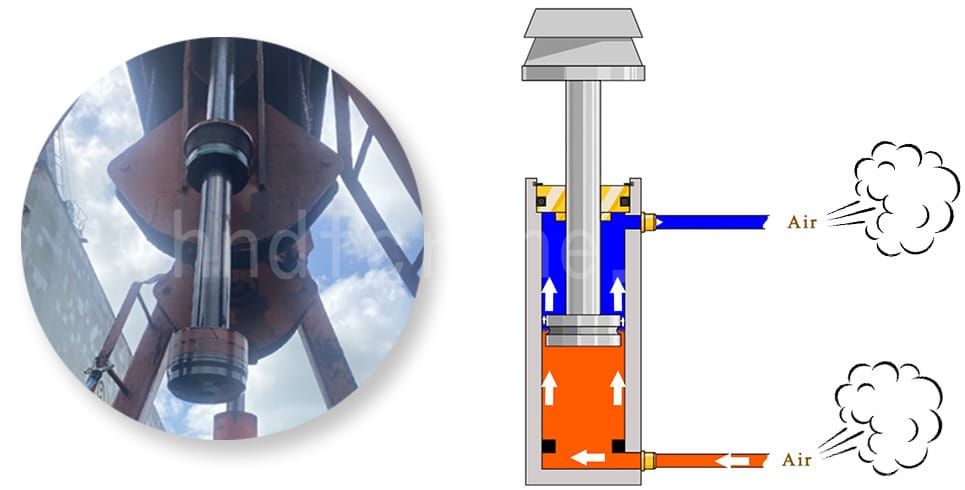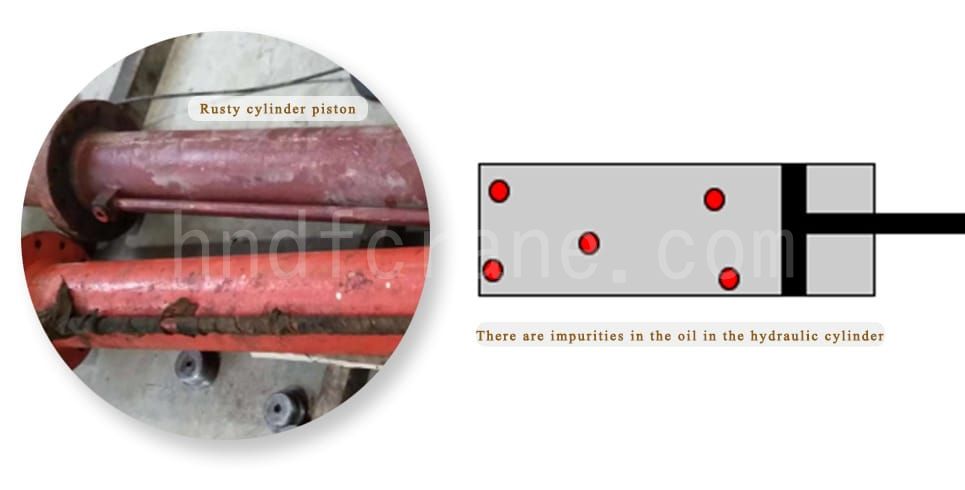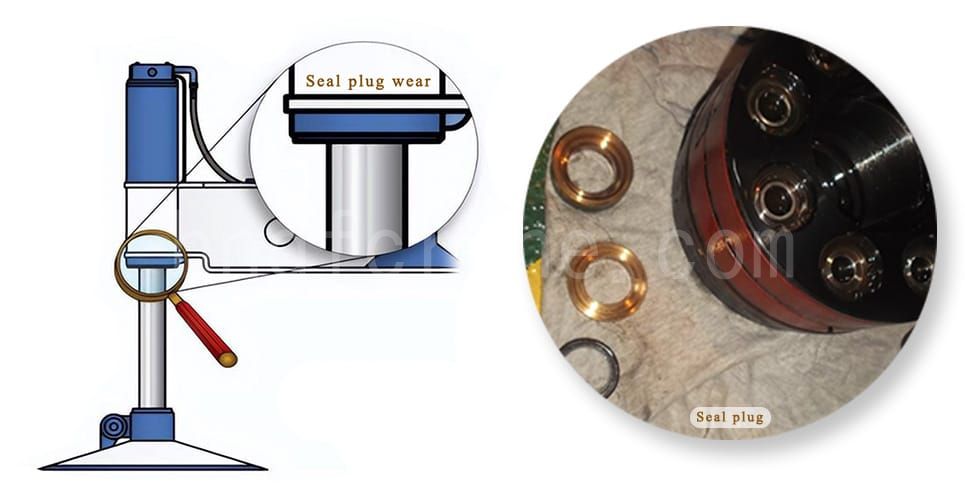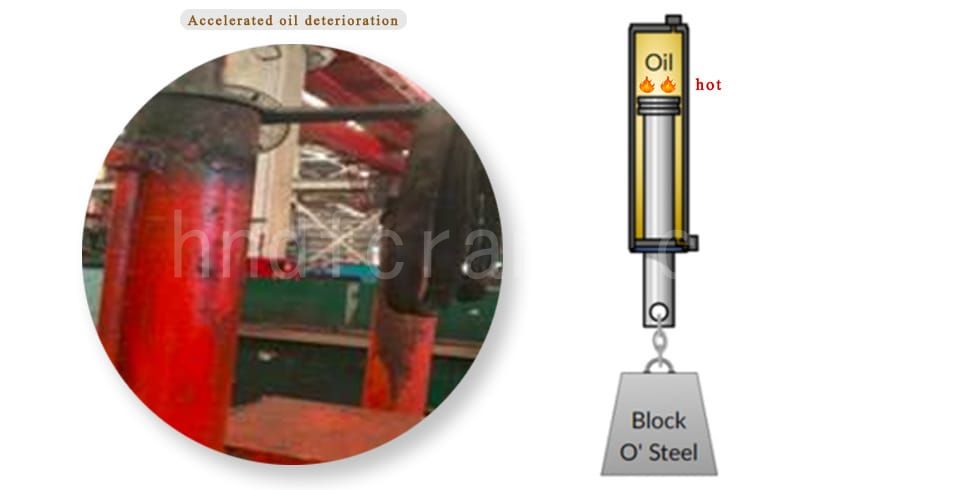4 ødeleggende hydrauliske gripefeil du må kjenne til
Innholdsfortegnelse

Vedlikehold av hydrauliske griper for kraner er avgjørende for å sikre normal drift og forlenge levetiden til utstyret. Hydrauliske gripere er ofte utsatt for ulike feil når de brukes i arbeid. De fleste av de hydrauliske gripefeilene til vanlige kranhydraulikksystemer i utstyr er forårsaket av overoppheting av hydraulikkolje, luftinntak, forurensning og oljelekkasje. På grunn av svikt i det hydrauliske systemet, vil svikt i hovedsystemet direkte føre til svikt i hovedsystemet, noe som resulterer i mer alvorlige økonomiske tap. Derfor er det viktig å analysere årsakene til disse hydrauliske gripefeilene og iverksette tilsvarende forebyggende tiltak. Denne artikkelen vil introdusere 4 vanlige feil og deres reparasjonsmetoder i detalj.
Hydraulisk gripefeil 1: Luft kommer inn i det hydrauliske systemet

Forårsak hydrauliske grep feil:
- Hydraulisk gripende sylinderstempel i bevegelsesposisjon.
- Den hydrauliske sylinderen til de hydrauliske gripene vibrerer eller lager unormale lyder.
- Den hydrauliske sylinderen til de hydrauliske gripene produserer lokal belastning og sintring.
- Som et resultat er senterlinjen til den hydrauliske sylinderen til de hydrauliske gripene ikke parallell med føringsskinnen til føringshylsen og er skjev.
- Den volumetriske effektiviteten til den hydrauliske pumpen til de hydrauliske gripene reduseres, energitapet øker, og det hydrauliske systemet kan ikke utøve sin tilbørlige effektivitet.
- Den termiske ledningsevnen til hydraulikkoljen i den hydrauliske sylinderen til de hydrauliske gripene forringes, og oljetemperaturen stiger, noe som forårsaker kjemiske endringer.
| Grunn | Løsning |
| Luft pustes inn på grunn av løse skjøter eller skader på oljetetninger og tetningsringer. | Hver skjøt skal festes godt og sørge for at drivstofftanken er godt forseglet, for å hindre at ekstern luft kommer inn og forurenser systemet, og samtidig tømmes ut. |
| Den oljeabsorberende rørledningen og rørledningen som forbinder systemet er slitt, riper eller korrodert, noe som får luft til å komme inn. | Design strukturen til det hydrauliske systemet rimelig for å rasjonalisere utformingen av rørledningen. |
| Luftbobler som genereres av uoppmerksomhet under tanking føres inn i drivstofftanken og blandes inn i systemet. | Eksosbehandling er nødvendig for å holde rørledningen ren og redusere ytre korrosjon. |
| Fremmedlegemer og fuktighet blandes i den hydrauliske sylinderen, noe som resulterer i lokal belastning og sintring. | Sylinderens indre vegg må poleres og årsaken til blanding av fremmedlegemer må finnes. |
| Feil installasjon av den hydrauliske sylinderen fører til at senterlinjen og føringsskinnen til styrehylsen ikke er parallelle. | Må installeres på nytt. |
| Sportsforseglingen er for stram. | Trenger å justere tetningen. |
| Stempelet og stempelstangen har forskjellige aksler. | Må korrigeres i henhold til monteringsanvisningen. |
| Styrehylsen og sylinderen er ikke på samme akse. | Må korrigeres i henhold til monteringsanvisningen. |
| Stempelstangen er bøyd. | Du må følge installasjonsinstruksjonene for å rette ut stempelstangen. |
| Den sylindriske graden av sylinderens indre diameter er ekstremt dårlig. | Trenger å bore og slipe sylinder sylinder, re-match stempelet. |
| Glideflaten sitter for stramt eller overflaten er børstet. | Trenger å skjerpe glideflaten. |
| Hvis stempeltetningen er skadet, vil oljen i høytrykkskammeret raskt renne tilbake til lavtrykkskammeret og lage en "brøl". | Stempeltetninger må skiftes. |
Hydraulisk gripefeil 2:Hydraulisk systemforurensning

Årsak feil:
- Forurensninger vil tette de hydrauliske komponentene til de hydrauliske gripene inn og ut av oljen eller mellomrom mellom dem, forårsake bevegelsessvikt, påvirke arbeidsytelsen eller forårsake ulykker.
- Det kan også føre til tilstopping av filteret og kan føre til at filteret fullstendig mister sin filtrerende effekt, og forårsake en ond sirkel i hydraulikksystemet til de hydrauliske gripene.
- Hydraulikkoljen og vannet til de hydrauliske gripene blandes.
| Grunn | Løsning |
| Det er mye støv i driftsmiljøet, og utsiden av systemet er ikke rent. | Når det hydrauliske systemet er i drift på et sted med alvorlig støvforurensning i lang tid, prøv å filtrere oljen en gang annenhver måned, og skift ut oljeinntaksfilteret en gang i omtrent et halvt år. |
| Urenheter føres inn i systemet under påfylling, inspeksjon av oljeoverflaten og vedlikeholdsoperasjoner. | Under vedlikehold, vær oppmerksom på renheten til oljesylinderen og prøv å utføre det i et støvfritt miljø. |
| Hvis temperaturen er for høy, vil hydraulikkoljen forringes. Hvis temperaturen er for høy, vil hastigheten som hydraulikkoljen forringes med, akselereres. | Hvis dette skjer, bør den elektrohydrauliske griperen kjøles ned. |
| Hydraulikkolje og vann blandes, og hvis det er vann i hydraulikksystemet, vil dette fenomenet oppstå. | Tetningen av det hydrauliske systemet til den elektrohydrauliske griperen bør kontrolleres. |
| Hvis det er urenheter i drivstofftanken til den elektrohydrauliske griperen, vil hydraulikkoljen bli forurenset av urenheter og forringes. | Kontroller og oppretthold et rent miljø i drivstofftanken i tide, og kontroller regelmessig. |
Hydraulisk gripefeil 3: Oljelekkasje i hydraulikksystemet

Årsak feil:
- Den hydrauliske sylinderen til de hydrauliske gripene kan bevege seg, men bevegelseshastigheten er for lav.
- Når det først oppstår en alvorlig lekkasje i det hydrauliske systemet til de hydrauliske gripene, vil trykket i systemet være utilstrekkelig, noe som fører til at skuffen ikke klarer å åpne og lukke normalt.
- Hydraulikkoljelekkasje kan også forårsake miljøforurensning, påvirke produksjonen, og til og med ha alvorlige konsekvenser som ikke kan anslås.
| Grunn | Løsning |
| Den brutale driften av hydrauliske komponenter i sammenstillingen, overdreven kraft vil deformere delene, spesielt ved å slå sylinderblokken og tetningsflensen med kobberstenger, etc. | Full oppmerksomhet bør rettes mot design og behandling av tetningsdeler i design- og prosessleddene. For å velge riktig monteringsmetode. |
| Deler blir skadet ved kollisjon under arbeid, noe som vil ripe opp tetningselementet og forårsake lekkasje. | Velg riktig forsegling for å forlenge aldringstiden. Vær oppmerksom på beskyttelsen av tetningen for å unngå at den blir ripet opp av andre deler. |
| Det er støv og urenheter i bruksmiljøet, og lekkasje oppstår hvis en egnet støvtett tetning ikke velges. | Når du velger og designer tetninger, bør du vurdere den kompatible typen hydraulikkolje og tetningsmateriale, belastningsforhold, arbeidshastighet, endringer i omgivelsestemperatur osv., og velg rimelige tetninger og egnede støvtette tetninger. |
| Deler er deformert eller skadet. | Må korrigeres eller erstattes direkte. |
| Oljetilførselen til den hydrauliske pumpen er utilstrekkelig, noe som fører til at trykket ikke går opp. | Feilsøking av hydraulikkpumpen. |
| Forårsaket av overdreven systemlekkasje. | Kontroller tetningsytelsen til hver komponent og rørledning. |
| Det er stanghulrom og stangløse hulrom i sylinderen, det vil si at en del av trykkoljen i høytrykkskammeret lekker fra stempeltetningen til lavtrykkskammeret. | Stempeltetningsenheten må skiftes ut. |
| Sylinderen eller stempelet til oljesylinderen er overslitt. | Du må vurdere om du skal slipe den eller erstatte den direkte. |
Fire lekkasjemetoder for hydraulisk system
- Gap lekkasje:Det er to hovedtyper av gap-lekkasje i det hydrauliske systemet til anleggsmaskiner, lekkasje ved den faste tetningen (statisk skjøtoverflate) og lekkasje ved den bevegelige tetningen (dynamisk skjøtoverflate). De lekkende delene av den faste tetningen inkluderer hovedsakelig leddet mellom sylinderhodet til den hydrauliske sylinderen og sylinderen; bevegelsestetningen inkluderer hovedsakelig stempelet til den hydrauliske sylinderen og den indre veggen til sylindersylinderen, mellom stempelstangen og sylinderhodets styrehylse. Størrelsen på spaltelekkasjen er relatert til faktorer som trykkforskjell og spalte.
- Porøs lekkasje: Forskjellige dekkplater i hydrauliske komponenter, på grunn av påvirkning av overflateruhet, er det umulig å få full kontakt mellom de to overflatene. I de mikroskopiske fordypningene der de to overflatene ikke er i kontakt, dannes det mange hulrom med ulike tverrsnittsformer og varierende størrelser. Tverrsnittsstørrelsen til hulrommene er relatert til overflateruheten. Flere hulrom lekker og væsken må strømme gjennom mange buede hulrom. Under tetningsytelsestesten tar det en viss holdetid før lekkasjen kan avdekkes.
- Lekkasje av slimfeste:Det er en viss adhesjon mellom den viskøse væsken og den faste armen. Etter at de to kommer i kontakt, festes et tynt lag med væske til den faste overflaten. Hvis filmen på den faste overflaten er tykkere, vil oljefilmen skrapes av tetningsringen på grunn av gjensidig bevegelse. Adhesjonslekkasje. Den grunnleggende måten å forhindre adhesjonslekkasje på er å kontrollere tykkelsen på det flytende adhesjonslaget.
- Strømlekkasje: På den forseglede overflaten av den roterende akselen, hvis det er spor av spiralbehandling når akselen roterer, strømmer væsken langs sporet til spiralsporet under påvirkning av rotasjonskraften til den roterende akselen. Hvis retningen til spiralsporet er i samsvar med rotasjonsretningen til akselen, vil strømlekkasje oppstå på grunn av "pumpeolje"-effekten til spiralsporet. Karakteristisk for kraftlekkasje er at jo høyere hastighet akselen har, desto større blir lekkasjen. For å forhindre strømlekkasje bør tilstedeværelsen av "pumpeolje"-behandlingsspor på tetningsoverflaten til akselen og leppen til tetningsringen unngås, eller prinsippet om strømlekkasje bør brukes, og oljepumpeeffekten til spiralspor bør brukes til å pumpe den lekkende oljen tilbake for å forhindre lekkasje.
Når det gjelder lekkasjemetoden, kan du se denne artikkelen for å lære mer:Lekkasje og dens effekter i ulike hydraulikkdrevne systemer
Hydraulic Grabs Failure 4: Hydraulikkolje overoppheting

Årsak feil
- Viskositeten til hydraulikkoljen og arbeidseffektiviteten til det hydrauliske systemet har alle redusert, og selv maskineriet og utstyret kan ikke fungere ordentlig i alvorlige tilfeller.
| Grunn | Løsning |
| Omgivelsestemperaturen er for høy, og den høye belastningen brukes i lang tid, noe som vil gjøre oljetemperaturen for høy. | Det bør unngås å arbeide kontinuerlig og under tung belastning over lengre tid. Hvis oljetemperaturen er for høy, kan utstyret brukes uten belastning i noen tid, og deretter fungere etter at oljetemperaturen synker. |
| Varmeavledningsytelsen til drivstofftanken er dårlig, noe som gjør at oljetemperaturen i drivstofftanken blir for høy. | Volumet av drivstofftanken, det vil si varmeavledningsområdet, bør økes, og en oljekjøleanordning skal installeres. |
| Feil valg av hydraulikkolje, kvaliteten og viskositetsgraden til oljen oppfyller ikke kravene, eller blanding av forskjellige kvaliteter av hydraulikkolje fører til at viskositeten til hydraulikkoljen blir for lav eller for høy. | Velg hydraulikkoljer som oppfyller standardene, og ikke bland to merker hydraulikkoljer. |
| Miljøet på byggeplassen er tøft. Med økningen av arbeidstiden til gripekranen, blandes oljen lett med urenheter og skitt. Den forurensede hydraulikkoljen kommer inn i parringsspalten til pumpen, motoren og ventilen, noe som vil ripe opp og ødelegge nøyaktigheten og ruheten til den sammenkoblede overflaten, noe som fører til at lekkasje øker og oljetemperaturen øker. | Overhal griperen regelmessig, skift ut den nye hydraulikkoljen i tide, og hold oljen i hydraulikksylinderen ren. |
Å forstå de vanlige feilene til disse 4 hydrauliske griperne kan ikke bare hjelpe deg med å reagere raskt når problemer oppstår, men enda viktigere, det kan sikre sikkerheten og effektiviteten til driften. Gjennom regelmessig vedlikehold og rettidig løsning av disse problemene kan du forlenge levetiden til utstyret ditt, redusere nedetiden og øke produktiviteten.
Hvis du ønsker å lære mer om hvordan du kan optimere ytelsen til gripekraner eller trenger profesjonelle reparasjons- og vedlikeholdstjenester, vennligst kontakt oss umiddelbart. La oss hjelpe deg med å holde den essensielle bruken i best stand og sikre en jevn drift av virksomheten din!
Send din forespørsel
- E-post: sales@hndfcrane.com
- Hva skjer: +86-191 3738 6654
- Tlf.: +86-373-581 8299
- Faks: +86-373-215 7000
- Legg til: Changnao industridistrikt, Xinxiang City, Henan-provinsen, Kina








































































